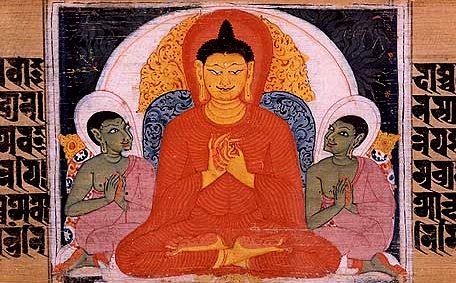http://greenyogaindia.com/prana-and-pranayama/
Remember Rishi Patanjali's eight-limbed Yoga?
- Yama
- Niyama
- Asana
- Pranayama
- Pratyahara
- Dharana
- Dhyana
- Samadhi
We've seen a little on asana - the physical posture - and on the last four limbs that deal with the mental posture.
Meditation, particularly Buddhist meditation, is often centered on watching the breath, just watching it go in and out without forcing it in any way.
Pranayama is completely different: we control breath.
Patanjali doesn't offer a very detailed explanation. The verses that refer to pranayama are only five: II-49 to II-53
49. Asana having been perfected, regulation of the flow of inhalation and exhalation is Pranayama.
50. Pranayama has external operation, internal operation and suppression. These, again, when observed according to space, time and number become long and subtle.
51. The fourth Pranayama transcends external and internal operations.
52. By that the veil over manifestation of knowledge is thinned.
53. Moreover, the mind acquires fitness for Dharana.
[Adapted from https://play.google.com/store/books/details?id=qUHabpdmSCkC)]
Apart from continual oral transmission, we had to wait almost 1000 years to have a detailed written instruction on pranayama, in the Hatha Yoga Pradipika.
Let's make a little experiment.
Lie down on your back and relax. Remember savasana?
Now pay attention to your thorax and abdomen and try to discern how they move with breath. Take your time...
If you're stressed (aren't we all?) you'll find that you are breathing from the top of your lungs. That's bad.
Now inhale deeply: begin by dilating your abdomen and then propagate the dilation to the chest, like a wave that begins just above the pubis and ends by the throat. Don't hold your breath; just let physics work and empty your lungs. When they're naturally emptied, there are still a few gases remaining: contract your chest and then the abdomen to expel the last possible ounce of residual gas. You've never taken such a deep, full breath in your life!
Traditionally the phases of breath are called
- Puraka - Inhalation
- Kumbhaka - Retention
- Rechaka - Exhalation
There is also kumbhaka after exhalation. If you are very mindful you can detect both kumbakhas even in your normal breathing. In fact, that's one of the advanced themes for Buddhist calm (samatha) meditation.
You may have noticed that the amount of air that flows through the left and right nostrils is not the same. This is natural. We have a dominant nostril, and it changes along the day - it is said that the dominant nostril changes every 108 minutes. If your dominant nostril is always the same, especially if you never breath through one of them, see a doctor: you probably have some physical obstruction.
When you do long breathing meditation (not pranayama) sessions you sometimes catch the dominant nostril slowly switching. It's a lot of fun...
Did this experiment make you want to further explore pranayama? Then sit. The ideal position for practicing pranayama is one of the meditative asanas that we've seen in a previous post on meditation.
I'm going to show you four pranayamas based on Swami Sivananda's The Science of Pranayama. The idea is to take a few minutes every day, preferably early in the morning, and practise one exercise during one week. Try not to skip steps. If at any time you feel dizzy, stop immediately. Your body is warning you that you are over-straining. As I said before, this is Yoga - not gymnastics!
First week: exercise #1
Close your eyes. Inhale deeply, as before, through both nostrils, very slowly and gently until your lungs are full. Remember that inhalation begins in the abdomen. Do not retain the breath. Then slowly exhale. Do twelve times. This will constitute one round. You can do two or three rounds according to your capacity, strength, and time at your disposal.
Second week: exercise #2
Close your eyes. Close the right nostril with your right thumb. Inhale very slowly through the left nostril as long as you can do it with comfort. Then exhale very slowly through the same nostril. Do twelve times. Do not make any sound during inhalation and exhalation. Then inhale through the right nostril by closing the left nostril with your right ring and little fingers and exhale very slowly through the same nostril. Do twelve times.
Vishnu Mudra - used for opening and closing nostrils.
http://sacred-earth.typepad.com/yoga/2008/07/mudras-for-pranayama.html
Third week: exercise #3
Close your eyes. Then inhale slowly through your left nostril. Close the left nostril with your right ring and little fingers and open the right nostril by removing the right thumb. Exhale very slowly through the right nostril. Then draw the air through the right nostril as long as you can do it with comfort and exhale through the left nostril by removing the right ring and little fingers. There is no kumbhaka in this pranayama. Do twelve times.
Fourth week: exercise #4
Close your eyes. Close the right nostril with your right thumb. Inhale slowly through the left nostril while mentally counting one-two-three. Using the ring and little finger, close the left nostril too and retain the air for the time it takes you to count to twelve; exhale through the right nostril for the time it takes you to count to six; keeping the right nostril open, inhale through it counting to three; close both nostrils while counting to twelve; open the left nostril and exhale through it while counting to six. Do twelve times.
As you have guessed, the aim is to have a 1-4-2 proportion for puraka-kumbhaka-rechaka.
From the end of the fourth week onwards you can try to slowly increase the time, by both slowing and deepening the steps. You began with 3-12-6; next week try 4-16-8. After a few months you may be able to get to 16-64-32 without undue strain.
Watch Baba Ramdev demonstrating pranayama.
http://ramdevyoga4all.blogspot.com/2010/07/complete-eight-pranayamas.html


























